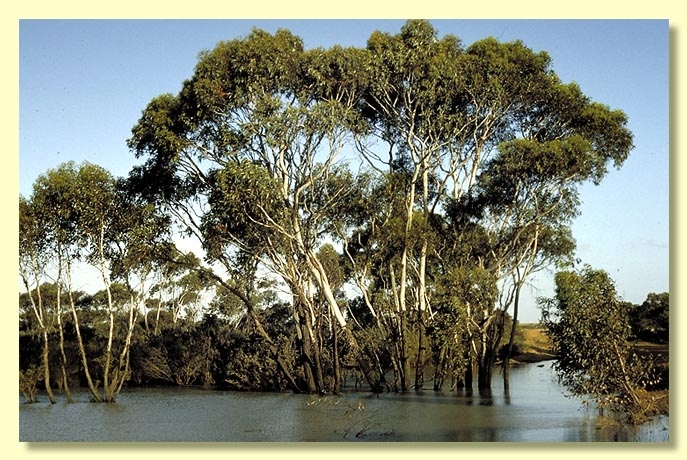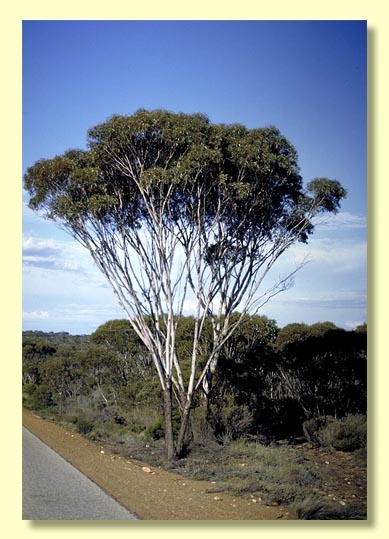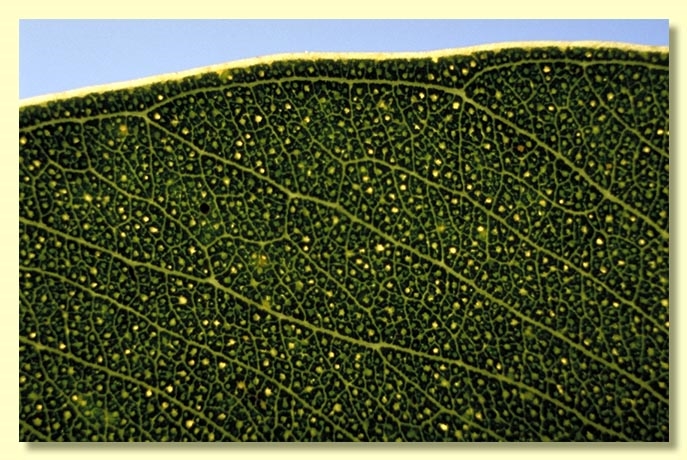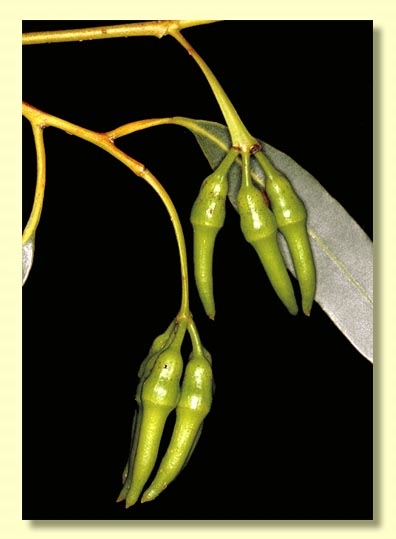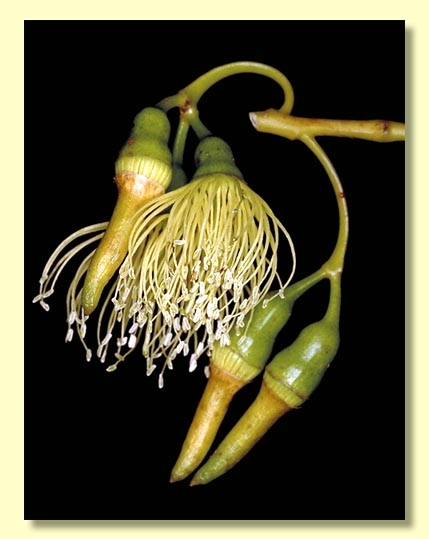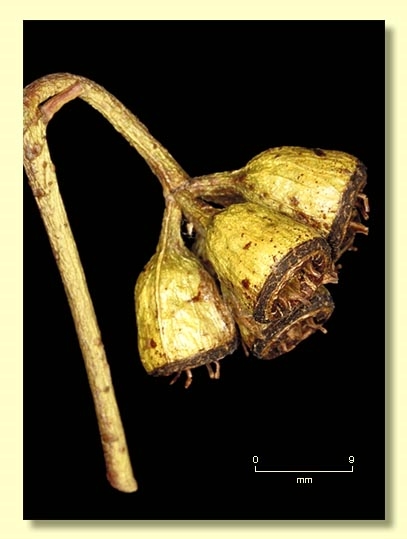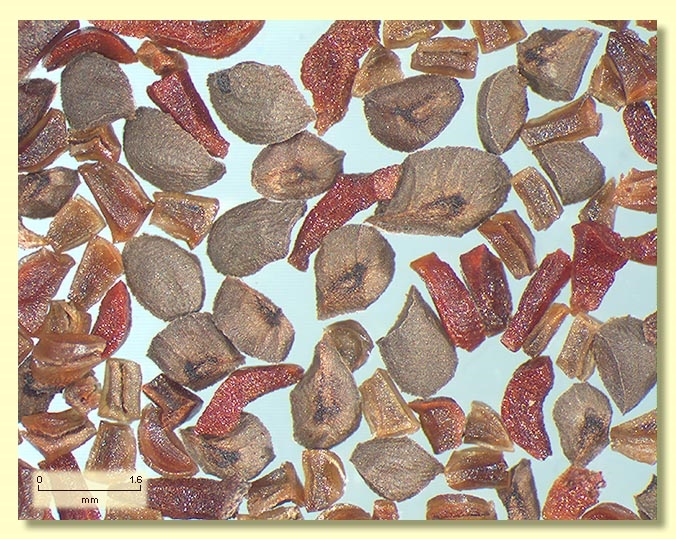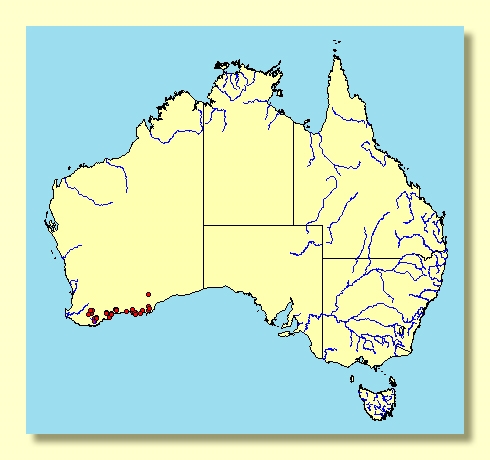Euclid - Online edition
Eucalyptus occidentalis
Eucalyptus | Symphyomyrtus | Bisectae | Glandulosae | Erectae | Pedicellatae
T: Fremantle, W.A., K.Hügel s.n.; holo: W; iso: K. The locality appears incorrect, since the species does not occur at or near Fremantle.
Eucalyptus agnata Domin, Repert. Spec. Nov. Regni Veg. 12: 389 (1913). T: Slab Hut Creek to Cranbrook, W.A., 1910, A.Dorrien Smith 7087; holo: PR; iso: K.
Bark rough over part or all of trunk, sometimes extending to large limbs, black to dark grey, fibrous, fissured and often hard, shedding in broad scruffy strips at its upper limit, smooth above, white to pale grey or pale grey-brown, sometimes powdery.
Branchlets have oil glands in the pith.
Juvenile growth (coppice or field seedlings to 50 cm): stems rounded in cross-section; juvenile leaves always petiolate, alternate, usually ovate, 6–13.5 cm long, 3–6.5 cm wide, dull, blue-green.
Adult leaves alternate, petioles 1–3.5 cm long; blade lanceolate, rarely falcate, 6.5–16 cm long, 1–3.5 cm wide, base tapering to petiole, margin entire, apex acute, concolorous, very glossy, green, side-veins at an acute or wider angle to midrib, reticulation moderate to dense, clear, intramarginal vein remote from margin, oil glands numerous, island, round.
Inflorescence axillary unbranched, pendulous, peduncles broadly flattened, 1.5–4 cm long, buds 7,9,11 or 13, pedicellate (pedicels 0.2–0.9 cm long). Mature buds elongated, 1.6–3.3 cm long, 0.5–1.0 cm wide, asymmetrically fusiform, swollen near the join of the operculum and hypanthium, scar present (outer operculum shed early), inner operculum horn-shaped, ca 1.5–2.5 times the length of the hypanthium, blunt or pointed, stamens erect, anthers oblong, versatile, dorsifixed, dehiscing by longitudinal slits, style long and straight, stigma blunt, locules 4 or 5, the placentae each with 4 vertical rows of ovules. Flowers pale lemon to cream.
Fruit down-turned, normally pedicellate, rarely sessile (pedicels 0.2–0.8 cm long), campanulate, 0.9–1.5 cm long, 0.8–1.3 cm wide, disc at first level then descending, valves 4 or 5, usually exserted, sometimes strongly so, rarely at rim level.
Seeds blackish brown, 1–2 mm long, angularly ovoid to flattened-ovoid, dorsal surface shallowly reticulate, hilum ventral.
Cultivated seedlings (measured at node 10): cotyledons Y-shaped (bisected); stems rounded in cross-section; leaves always petiolate, opposite for 3–5 nodes then alternate, deltoid to ovate, 4–8 cm long, 2.5–6 cm wide, dull, blue-green to grey-green.
Flowering has been recorded in April, May, August, September, October and November.
Recorded as becoming naturalised, spreading from windbreak plantings near Coonawarre on the Bellarine Peninsula of Victoria.
A tree or mallee endemic to Western Australia, of widespread distribution south and south-east of Perth, usually in wet, fresh-water depressions, but sometimes around salt lakes, from the southern wheatbelt and subcoastal areas north-west of Albany east to Cape Arid National Park and to the north of Mt Ragged. The bark is always rough over most of the trunk and conspicuously smooth white above, sometimes powdery, on the upper trunk and branches. The adult leaves are glossy green and elongated buds to 3.3 cm.
Eucalyptus occidentalis belongs in Eucalyptus subgenus Symphyomyrtus section Bisectae subsection Glandulosae because the buds have an operculum scar, cotyledons are bisected and branchlets have oil glands in the pith. Within this large subsection (ca 80 species) E. occidentalis is closely related to a group of mallees and mallets (series Erectae subseries Pedicellatae) recognised by the glossy green leaf surface, leaves with many oil glands but not obscuring the secondary venation, peduncles long and flattened or terete, inflorescences spreading to pendulous and buds with a long operculum and erect stamens arising from a narrow staminophore.
Within its natural distribution E. occidentalis is a distinctive species because of its habitat, habit and bark. In addition seedling or coppice growth is often present and is conspicuous with dull blue-green broad ovate leaves. Peduncles are flattened, buds are formed in clusters of seven to 13 and fruit are campanulate.
E. occidentalis is closely related to several species, viz. E. sargentii, a rough-barked tree species found always on saline sites, differing in having terete peduncles, smaller buds in clusters of seven and obconical fruit; E. aspratilis, a partly rough-barked mallee of seepages and granite rocks, in the Hyden-Norseman area, differing mainly in its much more cylindrical fruit shape and buds in sevens; and E. sporadica, a smooth-barked mallee from the extreme south of the wheatbelt to southern subcoastal heath, with buds in sevens and more obconical fruit. A related smooth-barked mallet species with a southerly to south-western wheatbelt distribution, E. astringens, differs in having much shorter and stouter buds than any of these species, still in clusters of seven, fruit that are campanulate and more or less smooth bark with some semi-detached curls of dead bark.
E. occidentalis is useful in cultivation in waterlogged sites and some provenances are salt-tolerant. The species is recorded as naturalized in Victoria near Ocean Grove.

